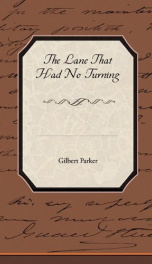The Lane That Had No Turning, Complete

The story with which this book opens, 'The Lane That Had No Turning',gives the title to a collection which has a large share in whateverimportance my work may possess. Cotemporaneous with the Pierreseries, which deal with the Far West and the Far North, I began inthe 'Illustrated London News', at the request of the then editor, Mr.Clement K. Shorter, a series of French Canadian sketches of whichthe first was 'The Tragic Comedy of Annette'. It was followed by 'TheMarriage of the Miller, The House with the Tall Porch, The AbsurdRomance of P'tite Louison, and The Woodsman's Story of the Great WhiteChief'. They were begun and finished in the autumn of 1892 in lodgingswhich I had taken on Hampstead Heath. Each--for they were all veryshort--was written at a sitting, and all had their origin in truestories which had been told me in the heart of Quebec itself. They wereall beautifully illustrated in the Illustrated London News, and in theiralmost monosyllabic narrative, and their almost domestic simplicity,they were in marked contrast to the more strenuous episodes of thePierre series. They were indeed in keeping with the happily simple anduncomplicated life of French Canada as I knew it then; and I had perhapsgreater joy in writing them and the purely French Canadian stories thatfollowed them, such as 'Parpon the Dwarf, A Worker in Stone, The LittleBell of Honour, and The Prisoner', than in almost anything else I havewritten, except perhaps 'The Right of Way and Valmond', so far as Canadais concerned.I think the book has harmony, although the first story in it coverseighty-two pages, while some of the others, like 'The Marriage of theMiller', are less than four pages in length. At the end also there arenine fantasies or stories which I called 'Parables of Provinces'. Allof these, I think, possessed the spirit of French Canada, though all aremore or less mystical in nature. They have nothing of the simple realismof 'The Tragic Comedy of Annette', and the earlier series. These ninestories could not be called popular, and they were the only storiesI have ever written which did not have an immediate welcome from theeditors to whom they were sent. In the United States I offered them to'Harper's Magazine', but the editor, Henry M. Alden, while, as I know,caring for them personally, still hesitated to publish them. He thoughtthem too symbolic for the every-day reader. He had been offered four ofthem at once because I declined to dispose of them separately, thoughthe editor of another magazine was willing to publish two of them.Messrs. Stone & Kimball, however, who had plenty of fearlessness whereliterature was concerned, immediately bought the series for The ChapBook, long since dead, and they were published in that wonderful littleshort-lived magazine, which contained some things of permanent valueto literature. They published four of the series, namely: 'The GoldenPipes, The Guardian of the Fire, By that Place Called Peradventure,The Singing of the Bees, and The Tent of the Purple Mat'. In England,because I would not separate the first five, and publish themindividually, two or three of the editors who were taking the Pierreseries and other stories appearing in this volume would not publishthem. They, also, were frightened by the mystery and allusiveness of thetales, and had an apprehension that they would not be popular.Perhaps they were right. They were all fantasies, but I do not wishthem other than they are. One has to write according to the impulse thatseizes one and after the fashion of one's own mind. This at least can besaid of all my books, that not a page of them has ever been written toorder, and there is not a story published in all the pages bearingmy name which does not represent one or two other stories rejected bymyself. The art of rejection is the hardest art which an author hasto learn; but I have never had a doubt as to my being justified inpublishing these lit --This text refers to the Kindle Edition edition.
Info about the book
Author:
Series:
Unknown
ASIN:
B004TS2WEQ
Rating:
3/5 (1)Your rating:
0/5
Languge:
English
Users who have this book
Users who want this book
What readers are saying
What do you think? Write your own comment on this book!
write a commentGenre
if you like The Lane That Had No Turning, Complete try:
Other books by this author
Do you want to read a book that interests you? It’s EASY!
Create an account and send a request for reading to other users on the Webpage of the book!





